Cantaloupe grows well in different types of soils. Loamy soil is best for growing Cantaloupe, and in sandy-type loamy soil, the crop can be completed quickly, and the clay loamy soil may be ready for harvesting a little late. However, the soil should not crack in summer, and water should not be logged during the rainy season. Let’s check out how to prepare the soil for Cantaloupe plants.
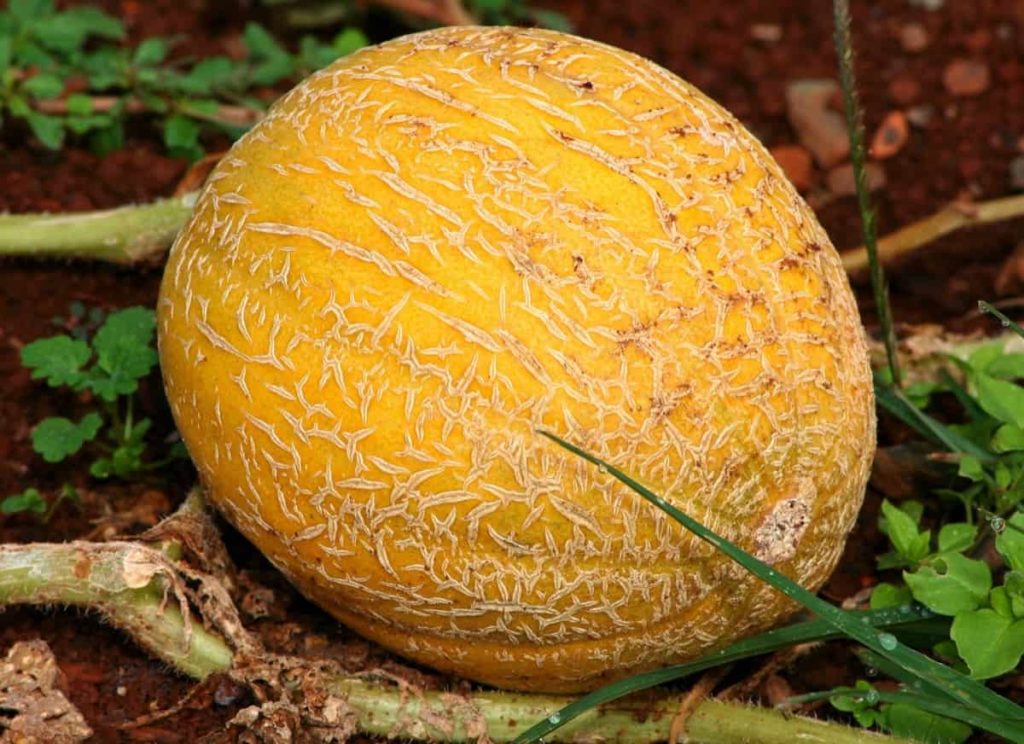
Well-drained loamy soil is preferred for all the cucurbits, including Cantaloupe, Cucumber, and Watermelon. The vine’s growth in heavy soil will be high, and the fruits will mature late. You can reduce the risk of diseases, by not planting where Cantaloupe, Watermelon, Squash, Cucumber, or Pumpkin have been grown during the last three years. Cantaloupes are annual hot weather plants susceptible to freezing temperatures at any growth stage.
They grow best in sunny, warm weather, with minimal rainfall and low humidity, and they are usually planted after frost in spring is no longer a concern. Sandy soil is used for early plantings as they warm up more quickly in spring, while due to high water keeping capacity, loam and clay loam soil are preferred for production due to water holding capacity, which favors a prolonged harvest period.
Cantaloupes thrive in hot, sunny places. Ground temperature should be at least 21°C before planting your seeds. If you’re in a cold region, you can start your Cantaloupes indoors, but you’d like to move them before they get too big for the best results. Be sure that when you are planting, you leave space for growing vines to arrive. If the space is limited, consider making a trailless for the vertical growth.
How to prepare the soil for Cantaloupe plants
Soil pH for Cantaloupes
Soil pH testing kits are the easiest way to determine the pH of the soil in your outside space. The pH of the ideal soil for planting Cantaloupes ranges from 6.0 to 6.5. Growing Cantaloupes in soil with more than 6.5 pH can make the leaves yellow, a condition known as iron chlorosis. Aluminum sulfate immediately reduces the soil’s pH, while sulfur is more gradual.
The exact amount of pH-changing soil modification you need to use depends on your current pH level and the products used. You may need up to 1.3 kg of aluminum sulfate for every 10 square foot plantation area or 680 grams of sulfur for every 10 square feet. You should follow the manufacturer’s recommendations for the best results. Excessive acidic soil can be equally harmful to your crops.
Growing Cantaloupes in less than 6.0 pH soil can produce yellow leaves and irregular fruits. Ground agricultural limestone is available in four varieties: pulverized, pelleted, granule, and hydrated. Wood ash is less effective than limestone but contains nutrients such as boron, phosphate, and potassium. Organic options include adding compost or manure and alkaline products that will increase soil pH while adding nutrients and increasing soil drainage.
Preparation of soil for growing Cantaloupes on grounds
Cantaloupe plants thrive in hot, moist, well-drained sandy or loamy soil. Planting outside should not start until the soil is warmed to at least 21°C. Low soil temperature slows down germination and growth. Cantaloupes require nutrients, so before planting, add about 4 inches of organic matter and follow it up with 4 to 6 cups of a complete granular fertilizer per 100 square feet of plantation area.
In case you missed it: 15 Common Cantaloupe/Muskmelon Plant Problems: How to Fix Them, Solutions, and Treatment
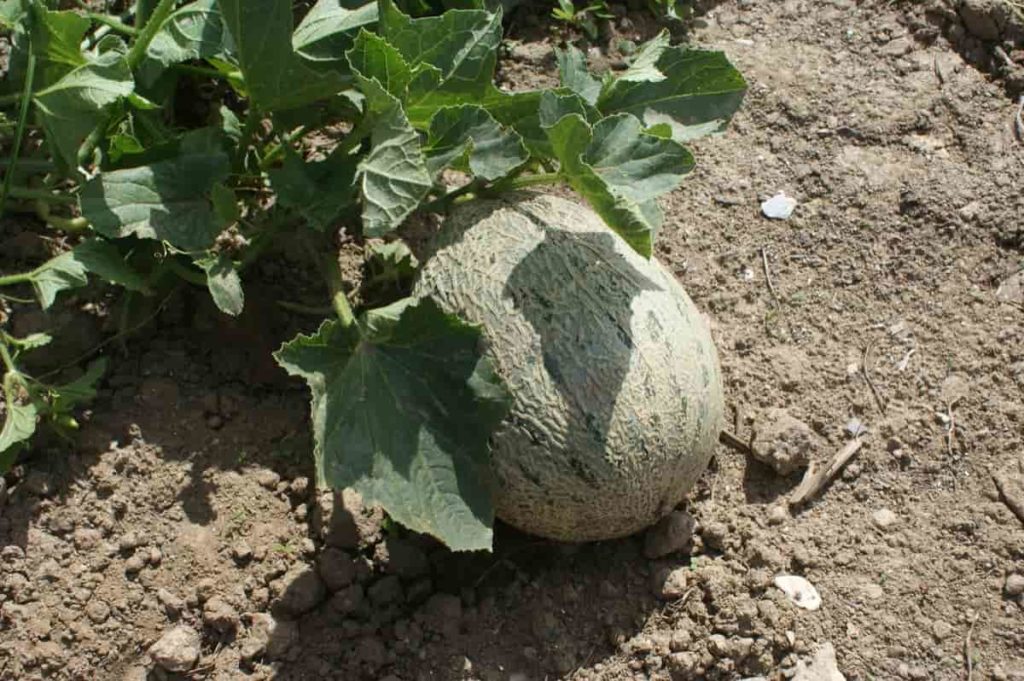
When the soil is hot enough to start planting, plant transplants or seeds in raised mounds of soil or hills to maintain the sun’s heat and improve drainage. After growing, thin out Cantaloupe plants, so you only have two or three healthy seedlings in each mound.
Preparation of soil for growing Cantaloupes in pots
While growing Cantaloupes in containers is a space-saving solution, adding a strong trellis to support vines allows for extra sun exposure and air circulation through leaves. Tie the vines with a trellis with a soft tie and provide a mesh sling to help each fruit. Even compact cultivars need space to grow.
Plant your Cantaloupe seeds in pots at least 18 inches wide and equally deep. Fill the container with a combination of loose, rich potting mix or equal parts of compost, coarse sand, peat moss, or coconut coir. You can add a shovelful of well-rotten manure for extra nutrients. Water the planting well; then plant two or three seeds in each container 1/2 to 1 inch deep.
How to grow Cantaloupes in clay soil
Cantaloupes grow best in soil that drains excess water while at the same time maintaining the required amount for plant growth. If you have clay soil, you must modify it to increase the porosity and texture. In addition to adding sand to the soil, treating it with a substantial amount of organic matter like compost or manure is helpful to improve soil condition and increase porosity.
Like other Melons, Cantaloupes are heavy feeders. Therefore, adding enough nutrients to the soil is crucial before sowing seeds. Mature compost, all-purpose fertilizers, and manure are all good choices to increase nutrition. You can also add some manure with soil to the planting site. Regular fertilization is essential for the growth of healthy fruits.
Soil composting for Cantaloupe
Cantaloupe needs a lot of nutrients. While you can provide most of them by converting organic matter into the soil before planting, getting a soil test is not bad, so you can use fertilizers that target deficiency. However, avoid adding excessive nitrogen, as it will supercharge the growth of the leaves and produce undersized melons. The soil needs to be loose and well drained.
Organic fertilizers such as compost and rotten manure make the best fertilizer for Cantaloupes. However, the elements are not so concentrated in organic fertilizers, so you must use about 480 grams every 4 or 5 square feet. Compost and aged manure improve soil structure as well as fertility. Cantaloupe also benefits from the applications of high nitrogen fish emulation after the plant’s bloom.
In case you missed it: Best Fertilizer for Cantaloupe/Muskmelon – Homemade, Organic, Liquid, NPK, Compost, How and When to Apply

Land preparation for Cantaloupe
A few months before planting, primary tillage is done at a depth of 30 to 40 centimeters. Cantaloupes require a lot of nutrients, so it is recommended to use organic matter. Soil has to be kept moist. Plant Cantaloupe seeds 1/2 to 1 1/2 inches deep. Use deep plantations on sandy and drier soil. The seed will not grow at soil temperature below 15°C, and the fastest germination occurs at 32°C. For early production, Cantaloupes can be transplanted into bare soil and seeded or transplanted through plastic mulch.
You should be laid the black plastic 10 to 14 days before the expected plantation date for an increase in soil temperature. Black plastic effectively controls weeds and protects soil moisture. Cantaloupes are difficult to transplant. Seedlings must be grown to successfully transplant into peat pots, Seedling trays, or Jiffy pots. Transplants should be delayed until the risk of frost is past. After the plants are well established, between plants in seedy rows thin to 12 to 15 inches.
Best soil mix for Cantaloupe
Use a well-draining organic potting mix that contains perlite or vermiculite to grow Cantaloupe in containers. Adding some compost to the soil can also be a good idea to boost your plants. For a successful container garden, it is essential to use high-quality potting soil rich in nutrients and organic matter. Find a potting mix that includes perlite, peat moss, or coconut coir to maintain drainage and moisture.
Natural soil amendments for Cantaloupe
Amendments are not recommended till the soil is tested. Excessive nitrogen in the soil can boost leaf growth rather than good fruit production. If you have nutrient-poor soil, it is common practice to add manure when planting and then add balanced organic fertilizer (such as fish emulation) every few weeks. Follow the product label instructions for the amount of use.
You should modify the soil of this place with sand and compost, or you should give manure and water should be given before planting. Make a small mound everywhere, press two to three seeds about an inch deep into the soil in each mound, and cover them. If you are applying enough fertilizer (both horses or steers are great) and other plant-based fertilizers, you may not need to be fertilized often.
In case you missed it: Growing Muskmelon Indoors from Seed – a Full Guide
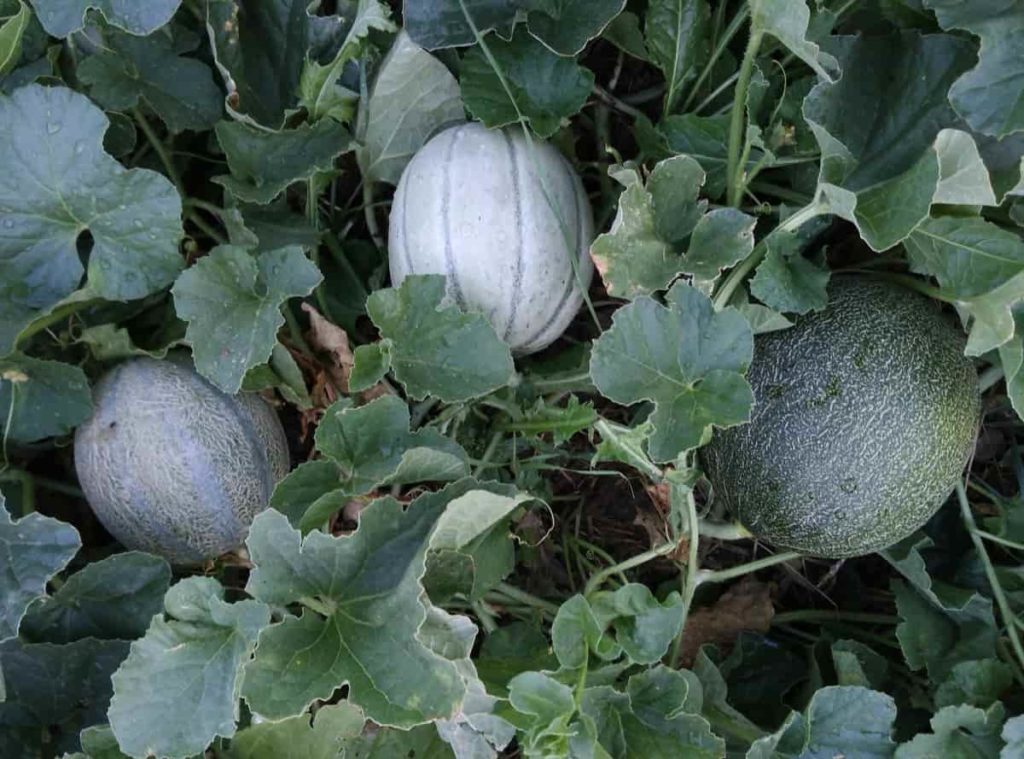
They will provide a good source of continuous nutrition for plants. You can apply a boost of balanced organic fertilizer during the growing season twice. Plants need nitrogen for vining when you grow Cantaloupes, but when they need phosphorus or potassium, a balanced fertilizer ensures they are there. You can side dress with plants with it or a couple of times with additional composted manure or compost to help them set the fruit.
It takes about three years to continuously add compost and organic matter to build the soil texture. There is enough slow-release fertilizer to maintain an organic garden comparable to the traditional green in production. It will take some years for some organic fertilizers to release their nutrients.
If you have a small garden or are just starting, you must supplement with weekly fish emulation, kelp, compost, or compost tea. When the vines are young and grow actively, they can use more nitrogen, but as plants mature, they need less nitrogen. Just remember that organic fertilizers should ideally be added in advance before you give them time to work.
What to do with soil when growing Cantaloupes
Cucumber beetles are sometimes a problem with young Cantaloupe plants. Cucumber beetles have yellow-green bodies with black spots or stripes. Squash bugs and squash vine borers attack both young and mature Cantaloupe plants. Squash bugs damage plants by sucking the sap from leaves. Nasturtium, Tansy, Catnip, Radish, Marigolds, Bee Balm, and mints are companion plants that prevent the attack of squash bugs.
In case you missed it: Best Fertilizer for Watermelon: Homemade, Organic, Compost, Natural, Liquid, When and How to Apply
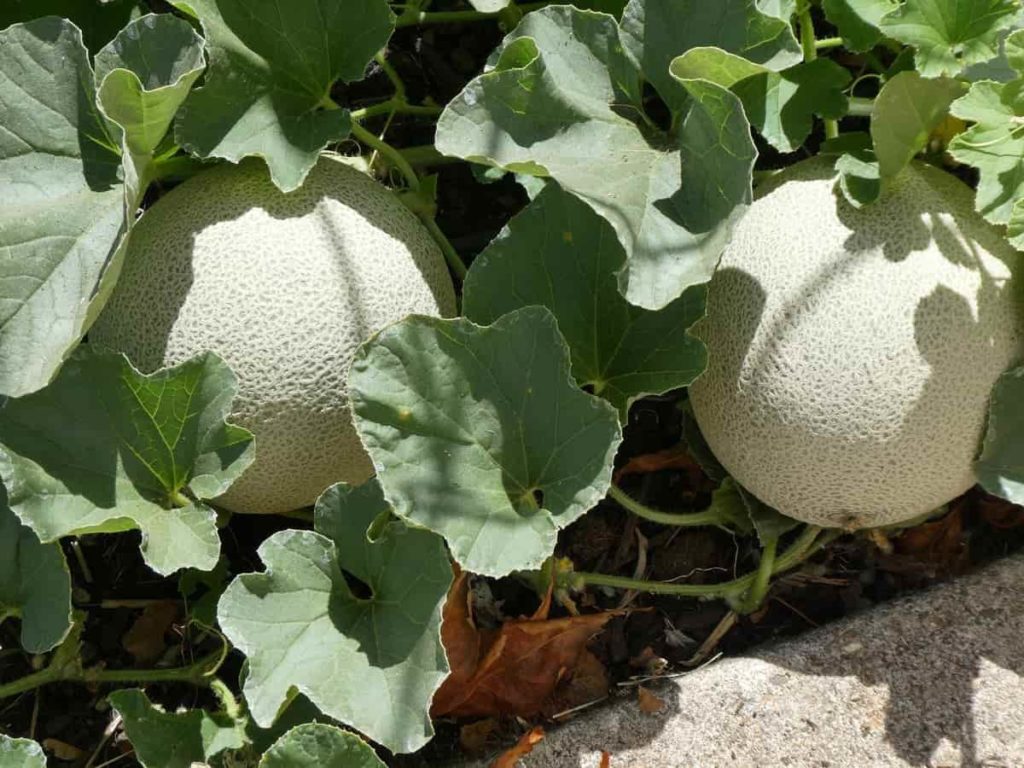
Nasturtium is powerful pest prevention (squash bugs, aphids, and striped cucumber beetles) used as companions of various plants, including Broccoli, Tomatoes, and more. However, when planted near Cantaloupes, it can become a disturbance for ants, white flies, and leaf hoppers. But not all plants can enhance your Cantaloupe’s taste and growth. It attracts predatory insects, but they won’t damage your melon. Instead, they will deal with pests and keep their population under control.
Marigolds, whose strong aroma acts as a repellent for many insects, including aphids, squash bugs, flies, beetles, and nematodes. Tansy can use to prevent flying insects, squash bugs, striped cucumber beetles, and ants. Collard green, which can lure aphids, is a type of sap-sucking insect that encourages the formation of black fungus and distorts the plant’s growth. Bee balm can attract pollinators. Strong smelling plants like Chamomile, Cilantro, Chives, Savory, Garlic, Onion, Anise, and Petunia.
They work well against insects like aphids as they can repel them with their intense fragrances. Shallow-rooted plants like Lettuce, tolerant of shade, grow rapidly and are easy to take care of. They won’t replace many roots, so there will be plenty of room to expand Cantaloupe vines. At the same time, they will take enough space to stop the weed flow.
Worst companion plants for Cantaloupe
One major plant you should avoid growing near Cantaloupes is its cousin, watermelon. For one thing, these two mostly attract the same insects (like the rest of the Cucurbitaceae family), so if you don’t let a disease get treated, it can spread quickly. Furthermore, these two plants can compete for space and thus nutrients, moisture, and light. However, it is unnecessary to risk the success of crops in this way, mainly because moisture and fungal diseases are notorious in dense vegetation.
In case you missed it: Summer Watering Guide: For Vegetables, Flowers, and Herbs
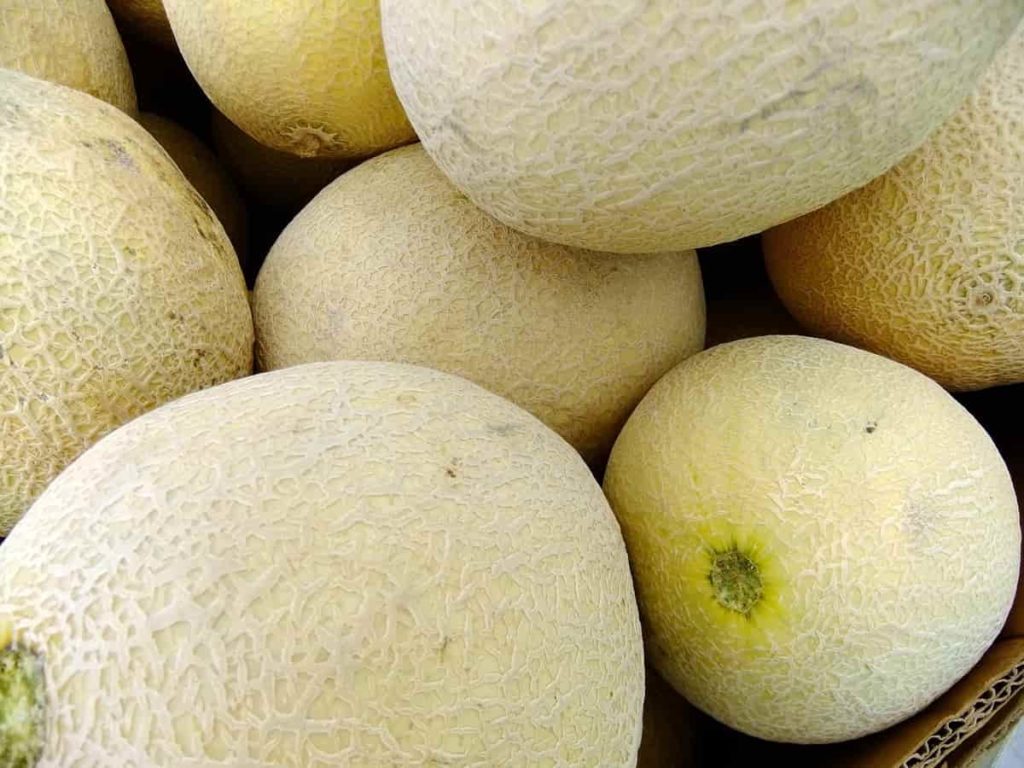
You should avoid cucumbers because (like Watermelons) they can attract insects and diseases that target both plants. Finally, be wary of planting Potatoes near Cantaloupes as they will usually compete for sunlight, soil, nutrients, and space. The worst part is that Potatoes can attract different types of aphids, especially melon aphids. The pests are known to feed similar plants like Cantaloupe, Watermelon, and Squash.
Conclusion
You can easily grow Cantaloupe plants, although some soil preparation steps ensure maximum growth and sweet fruits before planting and regular maintenance during the growing season. Melon cultivation requires extensive soil preparation before planting to be profitable and produce more. This article will help you how to prepare the soil for growing Cantaloupes.
- Broccoli Seed Germination and Selection
- Asparagus Seed Germination and Variety Selection
- Seasonal Flower Gardening: Best Practices for Spring, Summer, Fall, and Winter
- How to Grow Hibiscus from Flower
- Plantation Ideas for Home Decoration: A Beginners Guide
- Flower Garden Designs and Layouts for Beginners
- Planting and Spacing Techniques in Papaya: A Beginner’s Guide
- Growing Gold: Essential Techniques for Planting Pineapples
- How to Make Kalanchoe Plant Bushy: Home Remedies and Solutions
- 11 Reasons Why Your Gardenia is Not Blooming: Home Remedies and Solutions
- Eco Elegance: The Guide to Designing a Drought-Tolerant Landscape
- Gardening on a Slope: Strategies for Hillside Landscaping
- Nourish and Flourish: Top Organic Mulches for Thriving House Plants
- Everything You Want to Know about Indian Mogra Flower: Discover Uses and Growing
- Green Thumb Success: Expert Tips for Cultivating Greenhouse Pumpkins All Year Round
- Maximize Growth & Flavor: The Ultimate Guide to Companion Planting in Herb Gardens
- How to Control Rhododendron Problems Naturally: Home Remedies and Organic Ways to Fix Them
- Natural Magic: The Remarkable Benefits of Cinnamon for Plants
- Best Steps to Revive Dying Tulip with Natural and Organic Treatment
- 10 Reasons Why Your Angel Trumpet is Not Blooming: Remedies and Treatment
- How to Fix Periwinkle Leaf and Flower-Related Problems: Natural Remedies and Solutions
- How to Fix Zinnias Leaf and Flower Problems: Discover Natural and Home Remedies
- Organic Steps to Induce Lemon Tree Flowers: A Comprehensive Guide
- Bloom Booster: Crafting the Perfect Homemade Bougainvillea Fertilizer
- Optimizing Growth: A Guide to Applying NPK Fertilizer for Potted Plants
- 10 Best Homemade Fertilizers for Rubber Plant: DIY Recipes and Application Method
- How to Boost Female Pumpkin Flowers: Effective Steps for More Flowers and High Yields
- Transform Your Indoor Garden: Top Benefits of Pink Salt for Houseplants
- 10 Best Homemade Fertilizers for Peacock Plants (Calathea): Easy DIY Guide
- Unlock Blooms: 9 Reasons Why Your Potted Chrysanthemum is Not Blooming
- 8 Reasons Why Your Potted Hibiscus is Not Blooming: Fix it with Simple Solutions
- Unlock Blooms: 9 Key Reasons Your Potted Frangipani Won’t Flower
- 10 Reasons Why Is My Ice Plant Not Blooming: Remedies and Treatment
- 10 Reasons Why My Potted Hydrangea Not Blooming: Treatment and Remedies
- 10 Reasons Why is My Wisteria Not Blooming: Remedies and Treatment
- 10 Reasons Why is My Goldfish Plant Not Blooming: Remedies and Treatment